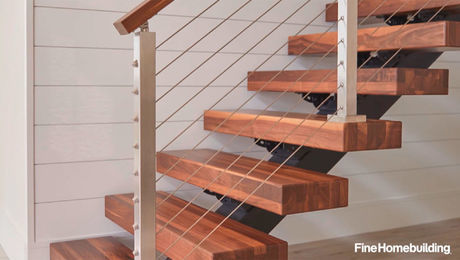*
Hi-
What is the best way to cut 3/8″ BX armored flexible conduit to length? What tool do I use etc…? Also, any tips for trimming it to length with the wires already run thru it?
Thanks!

Efficiency, solar power, and a sensitive kitchen for an 1830s house in New York.

"I have learned so much thanks to the searchable articles on the FHB website. I can confidently say that I expect to be a life-long subscriber." - M.K.
Get home building tips, offers, and expert advice in your inbox

Dig into cutting-edge approaches and decades of proven solutions with total access to our experts and tradespeople.
Start Free Trial Now
Get instant access to the latest developments in green building, research, and reports from the field.
Start Free Trial Now
Dig into cutting-edge approaches and decades of proven solutions with total access to our experts and tradespeople.
Start Free Trial NowGet instant access to the latest developments in green building, research, and reports from the field.
Start Free Trial Now© 2025 Active Interest Media. All rights reserved.
Fine Homebuilding receives a commission for items purchased through links on this site, including Amazon Associates and other affiliate advertising programs.
Get home building tips, offers, and expert advice in your inbox
Become a member and get instant access to thousands of videos, how-tos, tool reviews, and design features.
Start Your Free TrialGet complete site access to expert advice, how-to videos, Code Check, and more, plus the print magazine.
Already a member? Log in
We use cookies, pixels, script and other tracking technologies to analyze and improve our service, to improve and personalize content, and for advertising to you. We also share information about your use of our site with third-party social media, advertising and analytics partners. You can view our Privacy Policy here and our Terms of Use here.
Replies
*
Brian,
A hacksaw laid perpendicular to one of the armor turns works if you only have a few to cut.
At least two companies make manual cutters with a body that the cable lays into and a cutter wheel driven by a crank. GB makes one that I broke after three uses. Greenlee was what I replaced it with and it has held up fine.
These work on flexible conduit (no wires) and AC (commonly called BX) or MC cable. You have to set the depth on the cutter to avoid scoring the insulation on the wires. The Greenlee makes this quite easy with a set screw adjustment. Either one costs $25 around here.
*Thanks Scott!-Brian
*I just pull off the armour to expose as much wire as I need and then snip the armour with a pair of side cutters. It doesn't have to be real pretty because you're supposed to use anti-short bushings to protect the inner wires anyway.Cheers,Scott.
*Even easier than unwrapping all that %(()#$#$ armor is to hold it tightly between two hands and "untwist" it where you want to cut it off. It will unravel and pop open there. The side cutters do a fine job, and the rest slides off and discards really easily. You don't have that lllloooonnnngggg twisty tail getting in your way.
*Twist and snip. Wear gloves.
*the easiest way to cut bx is to first snip it with linesman pliers at the rough length (the overall length including wire at the ends) then you run down to the home center (one that is well stocked with electrical supplies) and buy the Greenlee Flexible conduit cutter. they work great it cuts the housing but doesn't nick the wire. the pros use them and they are cheap 15 bucks or so.
*Greenlee makes a BX and flexable conduit cutter Catalog # 1940.Works real slick.
*If this is the stuff that is sold at HD and is covered in plastic and you snake wire through it. I use my 4.5" angle grinder with a thin cut off blade in it. Very quick, clean and not alot of burrs to cut you with. I buy these connectors that threads into the conduit with a sleave that protects the wire at the cut. The connector has a thread on the other end with a nut to attach to the box. neat.
*I would like to add some more points:1) Another tool for cutting MC and AC cable is the RotoSplit. [This is perhaps a better quality version of the Greenlee or GB tools. That is, I was rather glad my Greenlee tool broke after falling off the ladder too many times, so I could justify buying one.] As mentioned, always use the insulating bushings (LRTs = "Little Red Things")2) Flex [i.e. the hollow stuff] can be broken by bending it sharply - both fists. Then the remaining strip of metal is cut with aviation snips. This works for 1/2" and 3/4" sizes. Otherwise use a hacksaw. [32 tooth blade preferred.]
*Thanks for the info, been looking for something better than what I have. Found some good pictures of the Roto-Split and Roto-Flex devices at:http://www.contractorstools.com/seatarmored.html(click on the highlighted name for a larger picture)
*Kerry :The plastic covered flexable conduit is known in the trade as Liqui-Tite. This is a brand name, but like Xerox, it is commonally used. This stuff is for outdoor use. Like A/C compressors and other objects that need a flexable wire to them that is waterproof. It cuts good with a hacksaw, fine tooth.Frank DuVal
*If you're cutting much liquid-tite, use a sawzall with a very fine toothed blade. A cordless recip (I've got the DeWalt) is just the ticket.
*My add on question is can i use this stuff in the ground? We have a large gopher problem and we need to put all electric cable inside something.I was thinking of using the flexable conduit and direct bury 12/3 wire. comments?? I get the stuff from my office. It is used under the raised floor in the mainframe computer room for power cords. I have seen it at home depot. When they change out equipment they need new power cords. The old stuff is put in the "dumpster" for our scavaging. I use it around the house and barn.
*Kerry,I think that routing your underground wiring thru the gopher holes will not work. You see, they usually dig the holes with sharp turns in them to protect against intruders.Better off just digging your own trench.
*Kerry, This is what happens when you don't have a Terrier nor a cat and not even a measly .50 cal. machine gun to deal with the gopher problem. You bring up an interesting aspect of the Code; to wit: using underground rated cable in Flex [the hollow stuff]. I'm too lazy to look it up in my Code book, but I would hazard a guess that it is not approved to use Flex underground. But on the other hand, that would seem to apply to Flex with individual wires, unsheathed. Since you are allowed to use the underground cable underground, it should not be a problem to use the flex as a supplementary form of protection. Be aware that what the gophers can't eat, rust will. Typically we install underground wiring in PVC conduit but in view of the rodent problem, the next step is to encase the PVC in concrete. -Peter
*Kerry,I agree with the line of logic that the UF cable is listed for direct bury, and the sealtite is simply mechanical protection. I do believe that you have to comply with conduit fill limits. The cable cross-sectional area can't be more than 53% of the conduit cross sectional area. See Table 1 of Chapter 9 of the '99 NEC.But, I suggest that you do it right the first time and install rigid conduit (heavywall) and pull THWN conductors through the pipe. Gophers and rust be damned!
*
Hi-
What is the best way to cut 3/8" BX armored flexible conduit to length? What tool do I use etc...? Also, any tips for trimming it to length with the wires already run thru it?
Thanks!